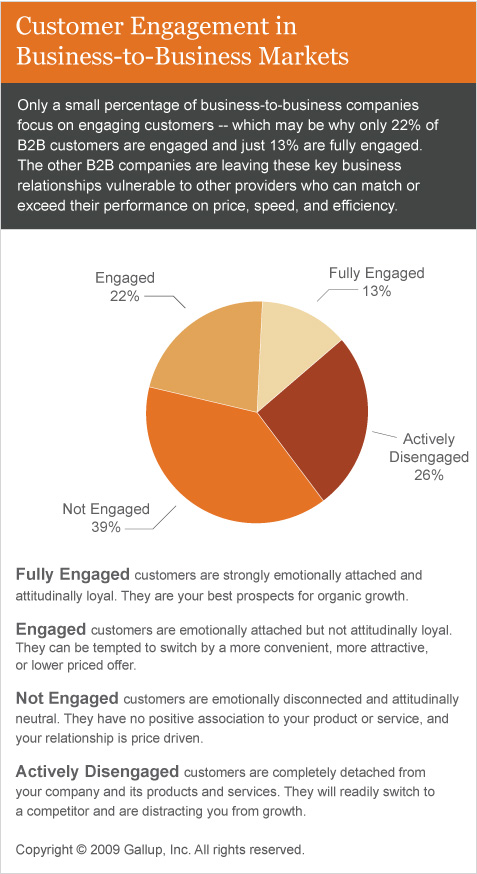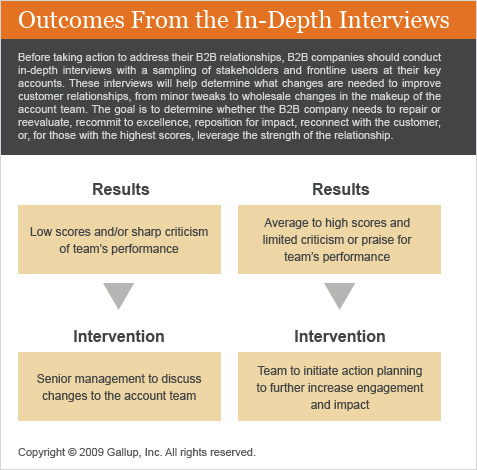It's commonly thought that business-to-business customers are uncommonly rational. The conventional wisdom is that, when buying for a business, customers are primarily concerned with objective factors such as price, speed, and efficiency. Only when people buy things for themselves do they get emotional about their purchases.
That conventional wisdom is probably completely -- and dangerously -- wrong. Yet this assumption underlies a worrisome statistic that Gallup uncovered in a study of thousands of business-to-business (B2B) relationships: 22% of B2B customers are engaged, and only 13% are fully engaged. The reason that such a small percentage of B2B customers are emotionally engaged is because only a small percentage of B2B companies focus on engaging customers. The other B2B companies subscribe to the conventional wisdom, believing that they need to appeal primarily to price, speed, and efficiency.

In fact, B2B customers are possibly more open to becoming engaged than business-to-consumer (B2C) customers. Think about it: If you buy the wrong brand of socks for yourself, you'll be annoyed for the single day you wear them. But if you buy the wrong firewall and virus protection service for your company and then your company's computer network implodes, you might lose your job. Because professional reputations and careers can be made or broken by B2B purchases, B2B customer engagement may be even more fraught with emotion than B2C relationships.
Engagement pays
But what is that emotion? You might think it has a lot to do with interpersonal relationships, and you'd be right. But that's only part of it. Whether it's B2B or B2C, customer engagement is built on four hierarchical needs. The baseline requirement is rational satisfaction, which comes from satisfying a customer's basic needs of price, speed, and efficiency. Companies that fulfill these basic needs will have customers that are more likely to be loyal, to recommend the company to others, and to continue as a customer. B2B organizations must satisfy customers at that baseline level because that is, literally, the least they can do.
Customer satisfaction may be a necessary foundation for building strong customer relationships, but by itself, it won't predict future customer behavior. The real difference in customer behavior -- and profitability -- comes from customers who are both rationally satisfied and emotionally engaged with your product or service. (See "Customer Satisfaction: A Flawed Measure" in the "See Also" area on this page.)
So how does a company with B2B relationships secure a sufficient level of engagement with its customers, particularly the top accounts that represent the bulk of its overall revenue? It must instill a sense of confidence with its customers, demonstrate its integrity, and create pride and passion around its brand and product or service offering. These four elements -- Confidence, Integrity, Pride, and Passion (along with the more rational elements associated with customer satisfaction) -- constitute what Gallup calls the customer engagement hierarchy. (See graphic "The Customer Engagement Hierarchy.")

If B2B customers are confident that the company will do what it says it will and that it has the integrity to treat customers fairly and resolve problems, if buyers are proud to be customers, and if its customers have a passionate conviction that there's no other B2B company like their favorite, then those customers are deeply emotionally engaged. And engaged customers have a profound effect on a company's bottom line. Fully engaged customers deliver a 23% premium over average customers in share of wallet, profitability, revenue, and relationship growth, while actively disengaged customers represent a 13% discount on the same measures, according to Gallup research.
Consider the following example from a professional services firm that Gallup studied. Customer engagement scores were tracked across 75 of the company's top accounts in Year Zero, then compared to account growth in Year One. Of the accounts with engagement scores at or above 4 out of a possible top score of 5, 21% of the accounts grew by 20% or more the following year, while 34% declined by 20% or more. Of the accounts with scores of less than 4 out of 5, 15% grew by 20% or more -- but 60% of these accounts declined by 20% or more, making lower engagement a prime indicator of future revenue decline.
And those numbers aren't even the most startling that Gallup has found. In a study at a financial services firm, we discovered a 33 percentage point difference in share of business between fully engaged and actively disengaged customers. In a manufacturing company, Gallup found a 37 percentage point difference between the fully engaged and actively disengaged groups. In a meat packing business, fully engaged customers' share of business topped that of actively disengaged customers by 29 percentage points, and one cargo carrier received 24 percentage points more share of business from its fully engaged customers than from its actively disengaged ones.
There are several levers a company can pull to drive the different elements of the customer engagement hierarchy. Some are rational, relating to the features of the product/service offering or the speed and efficiency of the service and delivery model. The others are emotional and lead the customer through the four levels of the hierarchy.
Selecting the appropriate levers is often difficult for a company. Each takes an investment of time, effort, and resources to implement. Many companies expend significant energy on measures that fail to connect with the customer on an emotional level or on measures that can be easily matched by the competition. This is particularly true of changes involving price. But when executed properly, the right measures can create strong points of differentiation for the company. They can engage.
Creating an impact
B2B businesses that want to take a disciplined approach to engaging customers first must identify what, exactly, causes customer engagement while maintaining the brand promise that made them attractive in the first place. The next step is to determine what actions they need to take to create an impact for their customers. "Impact" occurs when the B2B company, through its products and services and the breadth of its interactions with the customer, produces meaningful change in the customer's business. A B2B company will know it has created an impact when its customer can say: "This company knows my business and brings me new ideas. Our relationship enables me to create product innovations, new approaches to markets, and more efficient processes."
There is no way to know if B2B customers are engaged -- or if the B2B company is having an impact -- without measurement.
B2B companies that employ this approach are able to shift their customer relationships from price to advice. This not only fosters customer engagement, it provides a "stickiness" that is difficult for competitors to duplicate because it is often based on access that competitors won't have -- and it more than offsets the value of any proposed price reduction or discount. This doesn't negate the value of the more functional drivers of engagement, particularly those related to quality, utility, service, and responsiveness; to ensure growth, a B2B company still must meet customers' needs on the functional drivers of engagement. But emotional engagement also must be driven by the belief that a B2B company can -- and will -- produce tangible change and impact for the customer.
Measuring impact
There is no way to know if B2B customers are engaged -- or if the B2B company is having an impact -- without measurement. Customer engagement levels provide the clearest window a B2B company can have into the status of its accounts. Given the long and sometimes inconsistent purchasing cycles in B2B companies and the multiple layers of customer stakeholders a B2B company must deal with, without measurement, it might be easy to miss the early warning signs of a deteriorating relationship. Without a regular process for measuring the customer relationship, a B2B company might not discover a problem until it's too late.
That's why Gallup developed its own version of a balanced scorecard for B2B relationships. This scorecard provides a complex, yet holistic view of the account relationship and functions as both a diagnostic tool and a road map for the future. And it needs to do more than track revenue and profitability because there are so many touchpoints, purchasing cycles, and opportunities for inconsistency in B2B relationships.
A typical balanced scorecard includes several key areas, starting at Year Zero and progressing through Year One, Year Two, and so on. These areas include:
- 12-month revenue from the account
- gross margin
- 12-month revenue growth
- percentage of revenue from value-added services
- projected share of wallet
- customer engagement scores
- impact scores
- account team employee engagement
- value of outstanding bids/RFPs
When evaluating individual scorecards, B2B companies should examine the evolution of the relationship, the customer's perceived level and nature of impact the B2B company has delivered, the customer's assessment of individual team members, opportunities for development and improvement, and how the customer perceives the B2B company's strengths and weaknesses. And if your company can't identify these measures, you should ask the customer directly. Clients are usually more than happy to offer feedback when it comes to the strength of the business relationship; the key is to be flexible about scheduling time for a conversation.
Few B2B companies will have enough time or human resources to conduct an in-depth audit of all their customer relationships. One effective strategy is to sort your customers into "Tier 1" and "Tier 2" accounts. Tier 1 includes customers that provide 80% of your revenue. Tier 2 covers customers that provide 80% of the remaining 20% of your revenue, show high potential, or are accounts of significant strategic importance.
Intended -- and unintended -- consequences
Once the scorecard is complete, accounts can be ranked and evaluated based on their total score -- or their score in a particular category or combination of categories. Customers with low scores -- let's call them "red flag" accounts -- should receive immediate attention. Before taking action, however, the B2B company should conduct in-depth interviews with a sampling of stakeholders and frontline users, especially from Tier 1 accounts. These interviews will provide some of the detail underlying the scores. They also may uncover a level of urgency or frustration among certain customers that the scores alone may not provide.
One outcome of the interviews might be to change the makeup of the account team, particularly if the problems can be traced to specific team members or if the client is calling for a fresh start. In any case, the results will indicate, for every client, whether the B2B company needs to repair or reevaluate, recommit to excellence, reposition for impact, reconnect with the customer, or, for those with the highest scores, leverage the strength of the relationship. (See graphic "Outcomes From the In-Depth Interviews.")

All this information gives a B2B company crucial knowledge that it needs to evaluate its customer relationships and to set the strategy to deepen engagement. It also has a useful side effect: When a B2B company looks closely at its individual accounts and carefully considers what needs to change, it alters itself. It becomes more customer-centric. It starts doing the things that engage customers, sometimes without even realizing it. It moves from following unexamined conventional wisdom to intentionally managing its most profit-producing relationships. And that's the crux of customer engagement among B2B customers.
